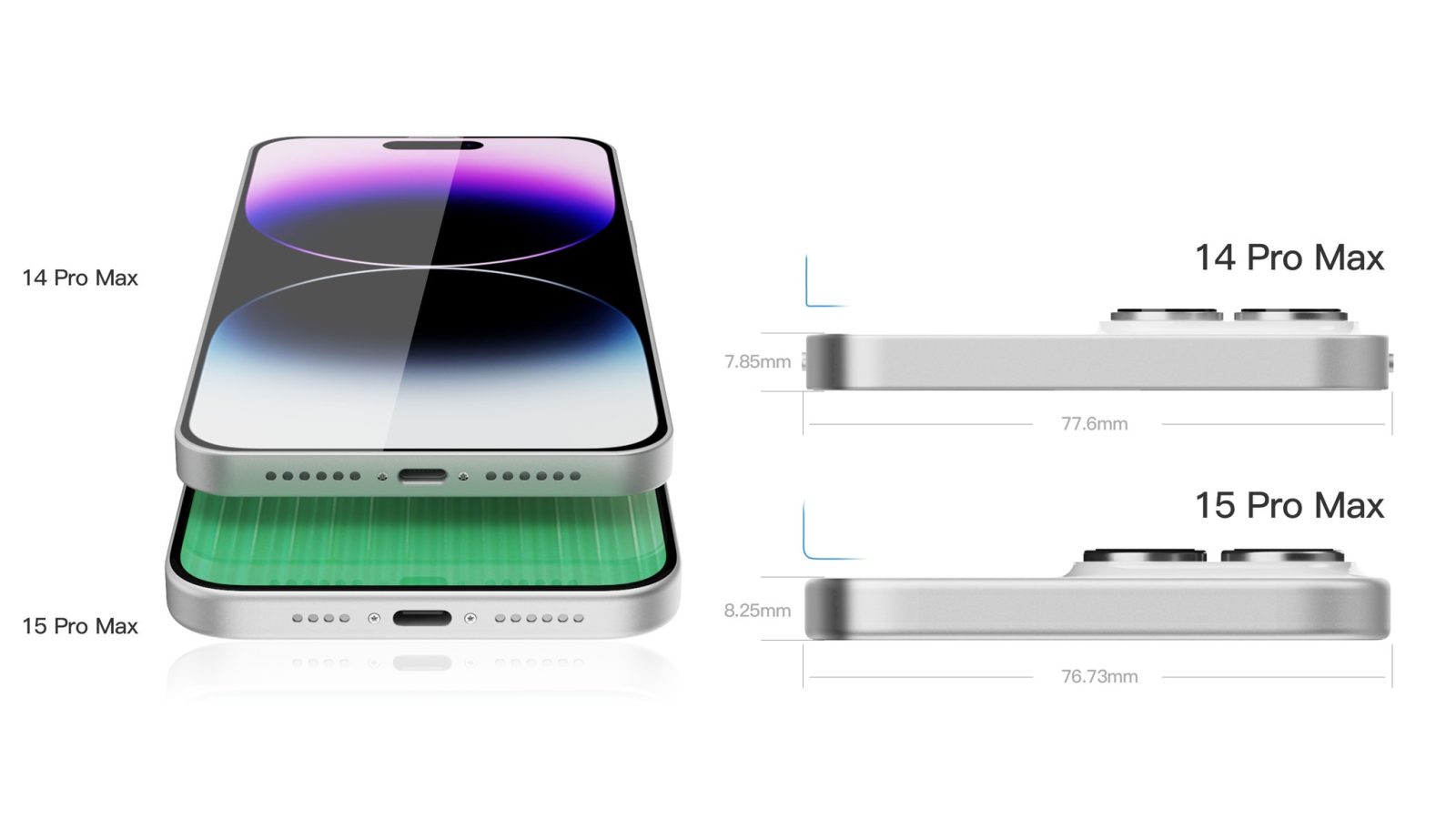Are you torn between the iPhone 15 Pro and the iPhone 14 Pro? Wondering if the latest iteration of Apple’s flagship smartphone is truly worth the hype and the price tag? In this comprehensive comparison, we’ll delve into every aspect of these two devices, from design and display to performance and camera capabilities. By the end of this article, you’ll have a clear understanding of whether the iPhone 15 Pro is a significant upgrade over its predecessor.
Design Differences
Let’s kick things off by examining the design disparities between the iPhone 15 Pro and the iPhone 14 Pro. The first impression often sets the tone for the entire user experience, and design plays a pivotal role in that initial encounter.
| Aspect | iPhone 15 Pro | iPhone 14 Pro |
|---|---|---|
| Weight | Lighter in the hand | Slightly heavier |
| Finish | Matte finish on the sides | Shiny finish on the sides |
| Buttons | Clickier, quieter power button | Less clicky power button |
| Action Button | Replaces mute switch, customizable | Traditional mute switch |
| Port | USB Type-C | Lightning |
| Back Glass | More shatter-resistant, cost-effective replacement | Prone to shattering |
The iPhone 15 Pro surprises with its lighter feel, thanks in part to the matte finish on the sides that enhances grip and reduces the chance of unsightly scratches. The power button, while quieter, offers a more satisfying click. The new action button, although requiring more pressure to press, adds versatility and customization options.
The switch to USB Type-C is a welcome change, enabling compatibility with a wider range of devices and faster data transfers. Plus, it allows for charging other devices, such as Android phones and AirPods, directly from your iPhone.
When it comes to durability, the iPhone 15 Pro’s redesigned back glass is less prone to shattering, making it a more cost-effective replacement. Overall, the design improvements on the iPhone 15 Pro make it a standout in terms of user experience.
Display Comparison
Moving on to the displays, let’s explore how the screens of the iPhone 15 Pro and iPhone 14 Pro stack up against each other.
| Aspect | iPhone 15 Pro | iPhone 14 Pro |
|---|---|---|
| Bezels | Thinner, uniform | Slightly thicker, not uniform |
| Dimensions | Slightly smaller and narrower | Slightly larger |
| Brightness | Identical | Identical |
| HDR Support | Excellent | Excellent |
| Resolution | Same | Same |
The iPhone 15 Pro’s display boasts thinner, uniform bezels, creating a sleek and modern look. Despite the slimmer profile, it manages to be slightly smaller and narrower than its predecessor, enhancing comfort in hand. The brightness, HDR support, and overall display quality remain on par with the iPhone 14 Pro.
However, what truly stands out is the consistent bezel thickness, which lends a more polished appearance to the iPhone 15 Pro. If you appreciate a visually pleasing display, you’ll find this aspect particularly appealing.
Action Button vs Mute Switch
One of the more intriguing changes in the iPhone 15 Pro is the introduction of the action button, which replaces the traditional mute switch. Let’s delve into how this new addition enhances user experience.
| Aspect | iPhone 15 Pro | iPhone 14 Pro |
|---|---|---|
| Action Button | Customizable, tactile feedback | Traditional mute switch |
| Usage Options | Focus modes, camera, flashlight, voice memos, and more | Mute switch |
| Button Size | Slightly larger, clickier | Smaller, less clicky |
| Button Feel | Requires more pressure to press | Quick and easy mute switch |
The action button on the iPhone 15 Pro offers a plethora of customization options, from switching between focus modes to activating the camera, flashlight, voice memos, and more. While it requires slightly more pressure to press, it provides tactile feedback that makes it easy to discern whether your device is in silent mode. The old mute switch, in comparison, offered quick muting but lacked the versatility of the action button.
Furthermore, you can customize the action button to open specific apps, offering added convenience. For example, you could set it to open your Tesla app for quick access to your car controls. This level of customization enhances the functionality of the iPhone 15 Pro, making it more versatile than its predecessor.
Speaker Comparison
Apple rarely emphasizes speaker improvements during its product launches, but they can significantly impact the overall user experience. Let’s compare the speakers of the iPhone 15 Pro and iPhone 14 Pro.
| Aspect | iPhone 15 Pro | iPhone 14 Pro |
|---|---|---|
| Sound Quality | Louder and clearer | Slightly quieter |
| Frequency Tuning | Higher frequencies stand out more | Lower frequencies detuned |
| Size | Smaller device, louder sound | Slightly larger device |
Surprisingly, the iPhone 15 Pro, despite its smaller size, delivers noticeably louder and clearer sound. Apple’s decision to emphasize higher frequencies allows for a more dynamic audio experience. In contrast, the iPhone 14 Pro tends to detune lower frequencies, resulting in a less balanced sound profile.
This enhancement in sound quality is a significant win for the iPhone 15 Pro and contributes to an improved multimedia experience, whether you’re watching videos, listening to music, or engaging in video calls.
USB-C vs Lightning
The transition from the Lightning port to USB Type-C is one of the most talked-about changes in the iPhone 15 Pro. Let’s delve into the implications of this shift.
| Aspect | iPhone 15 Pro | iPhone 14 Pro |
|---|---|---|
| Port | USB Type-C | Lightning |
| Charging Options | Greater versatility | Limited compatibility |
| Data Transfer | 20 times faster | Slower data transfers |
| Device Compatibility | Wider range of devices | Apple-centric ecosystem |
The adoption of USB Type-C in the iPhone 15 Pro brings greater versatility to your charging options. Not only can you use the same cable for your iPad, MacBook, and iPhone, but you can also charge other devices like Android phones and AirPods directly from your iPhone. Additionally, it facilitates faster data transfers, boasting speeds up to 20 times faster than the Lightning port.
Furthermore, the iPhone 15 Pro allows you to connect external devices such as SSDs and external displays. This newfound flexibility opens up a world of possibilities, from quick file transfers to enhanced productivity. However, it’s essential to note that the cable included in the box does not offer these high-speed transfers, so you may need to invest in a different cable for maximum performance.
The shift to USB Type-C represents a significant departure from Apple’s Lightning-centric ecosystem, expanding compatibility with a wider range of devices and accessories. While it may require some adjustments, it ultimately offers greater convenience and functionality.
Disk Speed Comparison
Now, let’s turn our attention to memory and disk speed, which can impact overall device performance and responsiveness.
| Aspect | iPhone 15 Pro | iPhone 14 Pro |
|---|---|---|
| RAM | 8GB | 6GB |
| Read Speed | Slightly slower | Slightly faster |
| Write Speed | Slightly faster | Slightly slower |
The iPhone 15 Pro comes equipped with 8GB of RAM, a welcome upgrade from the 6GB found in the iPhone 14 Pro. This additional RAM allows apps to remain open longer in the background without auto-closing, contributing to smoother multitasking and improved overall performance.
When it comes to disk speed, the iPhone 14 Pro has a slight edge in read speed, while the iPhone 15 Pro takes the lead in write speed. However, it’s important to note that write speed performance may vary based on the device’s storage capacity and available space. Both devices offer impressive disk speed capabilities, ensuring speedy data access and app loading times.
Geekbench 6 CPU Performance
To gauge the CPU performance of the iPhone 15 Pro and iPhone 14 Pro, we turn to the Geekbench 6 benchmark scores.
| Aspect | iPhone 15 Pro | iPhone 14 Pro |
|---|---|---|
| Single-Core Score | 29,250 | 26,000 |
| Multi-Core Score | 7,000 | 6,400 |
The iPhone 15 Pro, powered by the A17 Bionic chip, delivers a notable performance boost in both single-core and multi-core scores. It achieves a single-core score of 29,250, surpassing the iPhone 14 Pro’s score of 26,000. In multi-core performance, the iPhone 15 Pro also outpaces its predecessor, scoring 7,000 compared to the iPhone 14 Pro’s 6,400.
While these benchmark scores showcase improvements in CPU performance, it’s essential to remember that real-world usage may not always reflect these numbers precisely. Nevertheless, the iPhone 15 Pro’s A17 Bionic chip offers a tangible performance upgrade, particularly for resource-intensive tasks and gaming.
Geekbench 6 Metal GPU Performance
Now, let’s shift our focus to the GPU performance, crucial for gaming and graphics-intensive applications.
| Aspect | iPhone 15 Pro | iPhone 14 Pro |
|---|---|---|
| GPU Cores | 6 | 5 |
| Metal Score | 27,000 | 22,000 |
The iPhone 15 Pro’s GPU boasts an additional core, totaling six GPU cores, compared to the iPhone 14 Pro’s five. This extra core contributes to a substantial performance improvement, as evident in the benchmark scores.
In the Geekbench 6 Metal GPU test, the iPhone 15 Pro achieves a score of 27,000, while the iPhone 14 Pro lags behind at 22,000. This 20% performance boost in GPU capabilities promises a smoother gaming experience and improved graphics rendering for users who engage in demanding tasks.
It’s worth noting that this performance gain is not limited to gaming; it extends to any application that relies on GPU acceleration, such as video editing and 3D rendering.
3DMark Wild Life Gaming Performance
For a more comprehensive assessment of gaming performance, let’s turn to the 3DMark Wild Life benchmark.
| Aspect | iPhone 15 Pro | iPhone 14 Pro |
|---|---|---|
| Average FPS | 15 | 13 |
| Peak FPS | 30 | 24 |
In the 3DMark Wild Life benchmark, the iPhone 15 Pro shines with an average FPS of 15, outperforming the iPhone 14 Pro’s score of 13. When it comes to peak FPS, the difference becomes even more pronounced, with the iPhone 15 Pro hitting 30 FPS compared to the iPhone 14 Pro’s 24 FPS.
These results indicate that the iPhone 15 Pro not only offers a higher average frame rate but also maintains better performance during peak moments in gaming. This improvement promises a more enjoyable and responsive gaming experience for users.
3DMark Wild Life Stress Test
To evaluate thermal performance during extended gaming sessions, we conducted a 3DMark Wild Life Stress Test on both devices.
| Aspect | iPhone 15 Pro | iPhone 14 Pro |
|---|---|---|
| Throttling Behavior | Maintains performance, minimal dimming | Some performance loss, noticeable dimming |
During the 3DMark Wild Life Stress Test, we observed that the iPhone 15 Pro exhibited superior thermal performance. It maintained its performance levels with minimal dimming, ensuring a consistent gaming experience even during extended play.
In contrast, the iPhone 14 Pro experienced some performance loss and noticeable dimming, indicating that it may struggle to maintain peak performance under sustained load.
This thermal advantage of the iPhone 15 Pro is particularly significant for gamers and users who engage in resource-intensive tasks for extended periods.
Solar Bay Ray Tracing Performance
The iPhone 15 Pro introduces hardware support for ray tracing, a technology that enhances realism in graphics rendering. Let’s explore its impact on performance.
| Aspect | iPhone 15 Pro | iPhone 14 Pro |
|---|---|---|
| Ray Tracing FPS | 23.3 | 14.8 |
In the Solar Bay benchmark, which tests ray tracing capabilities, the iPhone 15 Pro demonstrates its prowess. It achieves an impressive 23.3 FPS, showcasing the hardware-accelerated ray tracing feature.
While the iPhone 14 Pro also manages to handle ray tracing, its score of 14.8 FPS falls significantly behind the iPhone 15 Pro. This difference highlights the tangible benefits of the A17 Bionic chip’s ray tracing capabilities, particularly in applications and games that leverage this technology for enhanced graphics.
Antutu Benchmark & Thermal Performance
The Antutu Benchmark allows us to assess overall device performance and thermal behavior.
| Aspect | iPhone 15 Pro | iPhone 14 Pro |
|---|---|---|
| Overall Score | 650,000 | 620,000 |
| Throttling Behavior | Maintains performance, minimal dimming | Some performance loss, noticeable dimming |
In the Antutu Benchmark, the iPhone 15 Pro achieves an impressive overall score of 650,000, surpassing the iPhone 14 Pro’s score of 620,000. This score reflects the device’s robust performance capabilities, driven by the A17 Bionic chip.
Similar to the 3DMark Wild Life Stress Test, the iPhone 15 Pro exhibits superior thermal performance during the Antutu Benchmark. It maintains its performance levels with minimal dimming, indicating its resilience under extended load. On the other hand, the iPhone 14 Pro experiences some performance loss and noticeable dimming, signaling potential thermal limitations.
5G Speed Test
The iPhone 15 Pro introduces a new Snapdragon X70 modem, promising improved 5G speeds. Let’s compare the 5G performance of both devices.
| Aspect | iPhone 15 Pro | iPhone 14 Pro |
|---|---|---|
| Download Speed | 400 Mbps | 247 Mbps |
| Upload Speed | 260 Mbps | 268 Mbps |
In our 5G speed test, both the iPhone 15 Pro and iPhone 14 Pro demonstrated impressive download speeds. However, the iPhone 15 Pro’s Snapdragon X70 modem showcased its capabilities by reaching download speeds of up to 400 Mbps, significantly outpacing the iPhone 14 Pro’s 247 Mbps.
On the upload front, the iPhone 14 Pro held a slight edge with upload speeds of 268 Mbps, while the iPhone 15 Pro achieved 260 Mbps. These results indicate that the iPhone 15 Pro excels in terms of download speed, offering faster connectivity for data-intensive tasks.
Camera Comparison
The camera systems on both the iPhone 15 Pro and iPhone 14 Pro offer exceptional capabilities. However, there are notable differences worth exploring.
Megapixel Upgrade
One of the significant camera upgrades in the iPhone 15 Pro is the introduction of a 24-megapixel mode, which is not available in the iPhone 14 Pro. While the difference in megapixels may seem minimal (24MP vs. 12MP), it becomes apparent in scenarios where finer details matter.
For example, when capturing text or intricate patterns, the 24-megapixel mode on the iPhone 15 Pro produces significantly sharper and more detailed images compared to the 12-megapixel mode on the iPhone 14 Pro. This enhancement extends to portrait shots and live photos, where the added megapixels contribute to richer and more detailed results.
Zooming Capability
The standout feature of the iPhone 15 Pro’s camera system is its 5x optical zoom lens. In contrast, the iPhone 14 Pro offers a 3x optical zoom lens. This difference in zoom capability provides users with more flexibility when capturing distant subjects.
In real-world scenarios, the 5x optical zoom on the iPhone 15 Pro allows for capturing intricate details even from a considerable distance. Whether you’re photographing wildlife, architectural details, or scenic landscapes, the 5x zoom lens enhances your creative possibilities.
Portrait Mode Enhancements
Both devices feature portrait mode for stunning depth-of-field effects. However, the iPhone 15 Pro introduces a noteworthy enhancement: the ability to create portrait effects even after taking a non-portrait photo.
This innovative feature allows users to add a portrait-like blur to photos that were initially captured without the portrait mode enabled. It’s a creative tool that provides more versatility in post-processing and allows you to experiment with depth effects on any image.
Low-Light Performance
Low-light photography is a crucial aspect of camera performance. In low-light conditions, the iPhone 15 Pro demonstrates superior image quality compared to the iPhone 14 Pro. The advanced image processing algorithms and improved hardware in the iPhone 15 Pro contribute to brighter and more detailed low-light shots.
Even with challenging lighting situations, the iPhone 15 Pro excels in capturing clear and vibrant images. This improvement is particularly valuable for users who frequently take photos in dimly lit environments or during nighttime.
Portrait Zoom and Detail
The 5x optical zoom lens on the iPhone 15 Pro not only excels in capturing distant subjects but also enhances portrait photography. When comparing portrait shots taken with the 5x zoom lens to those taken with the 3x lens on the iPhone 14 Pro, the difference in detail and background compression is evident.
Portraits taken with the 5x zoom lens exhibit a more pronounced background blur (bokeh) and greater subject separation. This feature is advantageous when you want to create striking portraits with a creamy, out-of-focus background.
Cropping vs. Zooming
For users who occasionally require zoomed-in shots beyond the capabilities of the 3x optical zoom on the iPhone 14 Pro, the iPhone 15 Pro offers an alternative solution. The 15 Pro’s 5x zoom lens enables users to capture distant subjects with exceptional detail, eliminating the need to crop and compromise image quality.
In a comparison where a photo was taken at approximately 4.9x zoom on both devices, the iPhone 15 Pro’s 5x optical zoom lens delivered significantly better detail and clarity. This result emphasizes the advantage of optical zoom over digital cropping.
Low-Light Zoom Performance
Low-light zoom photography is an area where the iPhone 15 Pro showcases its capabilities. In low-light conditions, both devices can use their optical zoom lenses. However, the iPhone 15 Pro demonstrates superior low-light zoom performance, capturing sharper and more detailed images.
Whether you’re zooming in on a dimly lit scene or capturing distant subjects in low light, the iPhone 15 Pro’s 5x zoom lens excels in delivering impressive results. This enhancement expands your creative possibilities and ensures that your low-light zoom shots are clear and captivating.
5x Lens and Low-Light
The introduction of the 5x optical zoom lens on the iPhone 15 Pro raised questions about its low-light performance. However, real-world testing reveals that the 5x lens on the iPhone 15 Pro performs admirably in low-light conditions.
Comparing low-light shots taken with the 5x lens on both devices, it’s evident that the iPhone 15 Pro maintains superior image quality. The images captured with the 5x lens exhibit more detail, better contrast, and richer colors, even in challenging low-light scenarios.
Smart HDR5 and Improved Processing
Both the iPhone 15 Pro and iPhone 14 Pro benefit from Smart HDR5, Apple’s advanced high dynamic range (HDR) technology. However, the iPhone 15 Pro’s A17 Bionic chip and improved image processing provide an edge in image quality.
Smart HDR5 enhances the dynamic range of photos, ensuring that both highlights and shadows are well-balanced. It preserves details in challenging lighting conditions, resulting in more vibrant and true-to-life images. The iPhone 15 Pro leverages its processing power to deliver even more impressive HDR results.
Non-Portrait to Portrait Conversion
An exclusive feature of the iPhone 15 Pro is the ability to convert non-portrait photos into portrait-style images. This feature, made possible by the A17 Bionic chip’s advanced processing capabilities, allows users to add depth-of-field effects and adjust focus even after taking a regular photo.
With a simple tap on the “Portrait” button during editing, users can transform ordinary images into captivating portraits with adjustable bokeh. This creative tool provides additional flexibility and creative control, expanding your options for post-processing.
Camera Conclusion
In the realm of photography and camera capabilities, the iPhone 15 Pro offers a range of enhancements that elevate the user experience. From the introduction of the 5x optical zoom lens to the 24-megapixel mode, the device empowers users to capture exceptional photos in various scenarios.
The improvements in low-light performance, Smart HDR5, and the ability to convert non-portrait photos into portrait-style images demonstrate Apple’s commitment to advancing camera technology. These enhancements not only cater to photography enthusiasts but also benefit everyday users seeking to capture stunning and memorable moments.
The iPhone 15 Pro’s camera system is a significant upgrade over its predecessor, the iPhone 14 Pro, and it undoubtedly contributes to the device’s overall appeal.
Should You Upgrade?
The question that often arises with the launch of a new iPhone model is whether it’s worth upgrading from the previous generation. Let’s sum up the key differentiators between the iPhone 15 Pro and the iPhone 14 Pro to help you make an informed decision.
Reasons to Upgrade to iPhone 15 Pro:
- Design Improvements: The iPhone 15 Pro boasts a lighter feel, matte finish for enhanced grip, and a more durable back glass.
- Action Button: The introduction of the action button, with customizable features, adds versatility and convenience to the user experience.
- USB Type-C: The transition to USB Type-C offers greater charging and data transfer options, making it more versatile.
- Enhanced Speaker: The iPhone 15 Pro delivers louder and clearer sound with a focus on higher frequencies.
- Increased RAM: With 8GB of RAM, the iPhone 15 Pro allows for smoother multitasking and better app performance.
- CPU and GPU Performance: The A17 Bionic chip offers significant improvements in CPU and GPU performance, resulting in faster and more responsive operation, especially for gaming and graphics-intensive tasks.
- 5G Speed: The iPhone 15 Pro’s Snapdragon X70 modem provides faster download speeds for data-intensive tasks.
- Camera Enhancements: The iPhone 15 Pro offers notable camera upgrades, including a 5x optical zoom lens, 24-megapixel mode, improved low-light performance, and innovative post-processing features.
Reasons to Stick with iPhone 14 Pro:
- Budget Considerations: If budget constraints are a significant factor, the iPhone 14 Pro offers a capable and slightly more budget-friendly option.
- Minimal Camera Needs: If you don’t require advanced camera features and are satisfied with the camera system on the iPhone 14 Pro, there may be less incentive to upgrade.
- Lighter Usage: For users with lighter multitasking and gaming needs, the performance gains of the iPhone 15 Pro may not be as critical.
- Sufficient Speed: If you find that the download speeds of the iPhone 14 Pro meet your requirements, you may not need the additional speed offered by the iPhone 15 Pro.
In conclusion, the decision to upgrade to the iPhone 15 Pro depends on your specific needs and priorities. If you value design enhancements, customization options, versatile connectivity, superior audio quality, and substantial improvements in camera capabilities, the iPhone 15 Pro is a compelling choice.
Moreover, if you engage in resource-intensive tasks such as gaming, graphics editing, and 5G data usage, the superior CPU and GPU performance, coupled with faster download speeds, make the iPhone 15 Pro a standout device.
However, if you’re content with the iPhone 14 Pro’s camera system, have more modest multitasking requirements, and don’t necessarily require the latest performance upgrades, the iPhone 14 Pro remains a capable device.
Ultimately, your decision should align with your unique preferences, usage patterns, and budget considerations. Both devices offer excellent features and performance, and choosing the right one for you depends on your individual needs and priorities.












